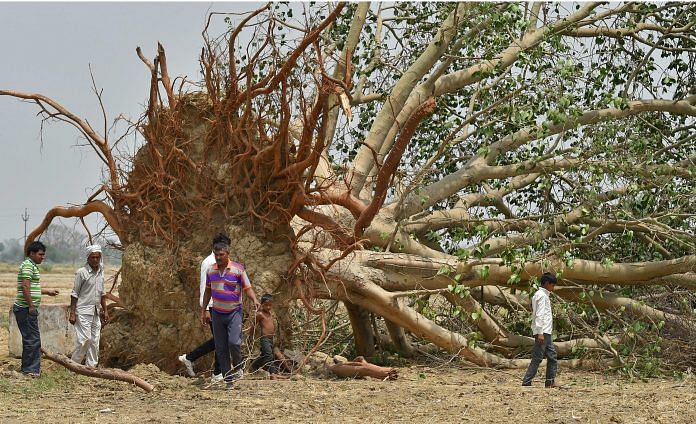The mechanisms for thunderstorms and dust storms are essentially the same; the only difference being that it’s a thunderstorm when there’s moisture, and a dust storm when it’s dry.
Bengaluru: The India Meteorological Department prediction for the next five days includes incessant thunderstorms and dust storms across several parts of India.
The warning says that there will be thunderstorms over Haryana, Punjab, Delhi, Uttarakhand, and even West Bengal, Odisha, and parts of Tamil Nadu, Karnataka, and Kerala. There are smaller storms predicted in the northeast, and dust storms in parts of Rajasthan. Heat wave-like conditions are expected in parts of Maharashtra.
Are these predictions unusual?
No, because thunderstorms and dust storms are common in summer. But also yes, because this pattern of severe weather events, accompanied by freak incidents, is seemingly becoming the new normal the world over. The intensity of thunderstorms as well as heat is increasing each year. The most recent winter in India was the third consecutive one to qualify as warm. In 2016, India recorded its hottest day in history, coinciding with four consecutive years of record-breaking heat. The year 2016 is globally the hottest year on record.
What causes such massive storms in summer?
The mechanisms for thunderstorms and dust storms are essentially the same; the only difference being that it’s a thunderstorm when there’s moisture, and a dust storm when it’s dry.
As the air over a region gets increasingly hot, it rises up while the colder air sinks. In this process of convection, the warm air also heats up the upper layers of our atmosphere. This warm air meets more warm air full of moisture that is blowing in from the Bay of Bengal, creating instability. The Himalayas divert these winds to other warm northern states beyond the northeast.
When the air runs out of moisture, but there are still low-pressure regions created because of heat, warm air full of dust rushes in to fill the void, causing deadly dust storms. Badly managed land resources, including exposed roadsides and urban dust, contribute to this.
The increasing number of heatwaves in our country is a leading cause for such freak storms. As of today, a large part of northern and north-western India is considered to be under a heatwave. Additionally, pollutants and industrial emissions in the air disperse across the nation, further maintaining warm temperatures.
What are the implications of changing temperatures?
Human casualties are a direct result. The death toll due to heatwaves is rising. As winters get warm and summers warmer still, Himalayan glaciers melt and retreat, threatening to flood the coastal plains of the Ganges and the Brahmaputra. Dust storms can affect and induce asthmatic attacks and other breathing problems, and can also carry with them large amounts of spores and viruses, spreading disease. Apart from human casualties, rapid fluctuations in seasonal temperatures could greatly affect crop yields, and thus farmers. Dry storms often blow off top soil, reducing fertility.
Storms can also set off cascading environmental effects. If seasonal migratory birds change their patterns in a year because of heat, they would affect the local fish and worm populations that function on a rhythm, which in turn affects local ecosystems. There are indirect, secondary effects too. Rising minimum temperatures during the winter put small-scale winter industries in north India at a risk, which in turn affects the sheep and dairy population, consumption, and prices.
How do we protect ourselves?
The simplest way is to remain indoors. If you are outdoors during a storm, it is advisable to stay away from trees as they are prone to lightning strikes. Swimming pools and large bodies of water are to be avoided too, as they can conduct electricity. An approaching storm’s distance can be measured by calculating the time difference between lightning and thunder: In the American way, you divide the gap in seconds between lightning and thunder by five, and that’s how many miles away a storm is. When indoors, again, avoid not only water but also handling electric equipment and plug points.
During dust storms, avoid stepping out, especially driving, on account of the diminished visibility. Dust storms are often formed when a large burst of air rushes outwards from a thunderstorm as well, so it is quite important to take cover for the thunderstorm that will follow.



